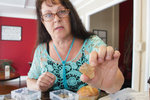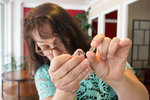

In various mines in Central Oregon, local artists search for a gemstone that Tiffany & Co. in New York City dubbed the “Plush Diamond.” These artists know it as the Oregon Sunstone.
“I would rate them as one of the highest value (gemstones) for the Pacific Northwest,” said Michael O’Neil, who is a Centralia-based facetor. “We really don’t have a lot out here. You can find gold, you can find agates, but there are not a lot of gem crystals. We just don’t have the geology for it. You get over in Montana where they have granite and you can find other types of things.”
The Oregon Sunstone forms in molten lava that is discharged from a volcano onto the earth’s surface. Once the lava weathers away, the crystals are visible. Central Oregon is one of the few places that produces this gem-grade feldspar.
“You walk out there and it looks like there is crushed glass everywhere,” said O’Neil of the mines.
Payette Still, who owns a dance studio and is also an artist, recently started her own jewelry line with these stones.
“To walk out there and just look out on the ground and it’s littered, just littered, with this stuff,” Still said. “It’s like you’re in wonderland. You’re in a treasure hunt — it’s so exciting.”
There are various mines in Oregon where visitors can find these stones. Still mentioned two near Plush, Oregon — Dust Devil Mining and Spectrum Sunstone Mines.
“There are a handful of people every day, but we have had the whole camp to ourselves pretty much all week,” Still said of Spectrum Sunstone Mines. “On the weekends, some people will come in.”
Before a facetor cuts the stones, they appear clear or a mild, yellow color — O’Neil described it as a “champagne” color. However, there are other colors visible inside the stones before they’re cut. This is the color Sunstones become when they are ready to be turned into jewelry.
“If you look into this, you see how there is a blob in the middle,” Still explained, holding up one of her uncut stones. “That is the color. So when it is faceted correctly, it will give you the actual color of the stones.”
The value of the stones fluctuates depending on its color. O’Neil said the stones that remain the champagne color after they’re cut are about $20 per carat. Teal green stones, which are the rarest, are as valuable as $1,000 per carat.
Still takes the stones she mines to O’Neil. He said that he cuts stones for five to 10 people every year, and that each person brings in as many as 20 stones.
O’Neil has traveled to the mines for about nine years.
“After about an eight-hour drive, you kind of drive up into the Oregon high desert,” O’Neil said. “Once you get over the mountains, it turns to pine trees, Juniper trees, then sagebrush — and that’s about all there is out there. Then you see all these RVs out in the desert and that usually signals there is somebody mining on a claim.”
O’Neil said the actual dig sites are basically open pits.
“There is a layer of basalt they have to take off (that is) 10-30 feet thick,” O’Neil said. “Then there is a layer with sunstones in it...They break up the host rock that the sunstones are in. They crush it sometimes, but it’s a lot of hand sifting.”
Still said it takes a few days to sort through the stones she finds and select the most valuable ones for faceting.
“If you’re not going to use a local facetor, you’re going to use someone overseas,” Still said. “You have to ship it off and that takes maybe a couple of months before the finished product ends up back with you.”
Still called O’Neil’s work “phenomenal.” She said it takes about three months from when the stone comes out of the ground until she has a finished piece of jewelry.
“Every piece is unique,” O’Neil said of the stones. “I personally find them very beautiful, all the different shades and different levels of copper inclusions. They’re all different and they all present a challenge and an opportunity at the same time.”